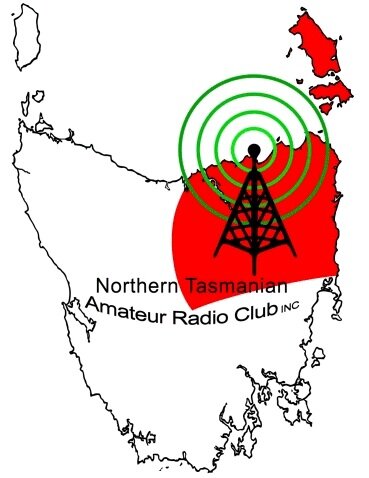Broadcast - 7 May 2023
Even though winter is rapidly approaching, and Wednesday Club Technical nights are getting colder, it is having no adverse effect on the attendance of members to get together and talk radio. This week was no exception with many technical offerings.
Andrew VK7DW, brought in his just arrived from Bulgaria, SG Lab, model PA1296 module. This unit switches a 50W Power Amplifier in for transmit mode and a Low Noise Amplifier when in receive mode, suitable for use on the 1296 MHz amateur band. Not a lot to describe, basically a small flat silver enclosure with one side completely taken up with a heatsink. On two of the narrow sides are three RF connectors, a DC power connector and a couple of LEDs to indicate the module status. As is usual with SG Lab you get a high standard of construction. I am assuming, if all goes well, it will be put through its paces during the next North South 1296 QSO after this Sunday broadcast.
Andrew’s other item was somewhat of an unknown curiosity, but eventually information was found. It used to operate on a much higher part of the frequency spectrum, visible light to be precise, and was manufactured over eighty years ago by the P.M.G. in Melbourne. It is a “Lamps Signalling Daylight, Short Range” unit. The purpose of the unit was to provide Morse communication by means of light flashes from a connected directional light bulb holder. Signals are readable during daylight at a distance of 3 km, with the naked eye, and 6 km by telescope. At night it may be read with the naked eye at 10 km and up to 20 km by telescope.
This is a self-contained portable unit and originally had a shoulder strap for carrying. The signalling lamp is unfortunately missing, and would have been transported within the wooden box. There are two lids at the top, one covering the lamp, and the second covering replacement bulbs, light filters and light stand and mounting spike. The lids are covered in canvas, probably there to prevent rain getting into the box. On the underside of one of the hinged lids is located a Morse key for controlling the lamp signalling. The unit also still has a battery made up of eight NiFe cells in series, which appear to be flat. These signalling lamps were in use from the Great War, through to the end of World War Two. It was the coming of reliable VHF radios that finally spelled the end for much of these visual signalling devices. A very interesting piece of history and we hope that Andrew can locate some of the missing parts.
Equipment - Morse and day light set in timber box with accessories (victoriancollections.net.au)
Ross VK7ALH, had three items from the Ten-Tec stable of equipment, all manufactured in America. Firstly a model 546 Transceiver, an HF 100W plus SSB / CW rig with matching Variable Frequency Oscillator or VFO for short, which could be configured for receive or transmit use.
The real item of interest was the third Ten-Tec unit placed on the bench, a model 544. This one was last seen at the club rooms back in 2019 when Ross brought in a cardboard box containing the remains of a salvaged transceiver, most of the case and a only a couple of the board compliment remained which I think, quite literally was salvaged from a rubbish skip. This one has come a long way, after a couple of years of tracking down replacement boards, Ross has nearly completed its restoration. It is so nice to see equipment saved from the scrap heap and able to live on.
A quick update on Peter VK7KPCs, latest “built from scratch” project. This is his PIXIE transceiver mentioned last week, a 300 milliwatt QRP Transceiver, designed by W1FB (SK) and was brought along hopefully for some on air testing. Peter successfully managed to make a CW contact with Nic VK7WW, on 7028 KHz. Nic was also QRP at 2.5 Watts, the lowest his Icom would go in power. He received Peter at a very respectable 549. Although not quite across the Atlantic it did however make it across the Tamar River. To top off a successful evening they found out that their QRP QSO was received in Victoria by Josh VK3ZB in Mitcham, approximately 26 km East of Melbourne.
Equipment pictures are available on the NTARC website under “Blogs” for this broadcast. Now back to the house keeping.
UPCOMING EVENTS
The TestNet and TechNet session - Wednesday the 10th of May. TestNet/CW course on 3.580MHz from 7pm till 7.30pm…. and a TechNet on 3.567MHz from 7.30pm till about 8.30pm. Your host for the evening will be Nic VK7WW.
Coffee Morning - held every Friday in the NTARC Club rooms. Time is from 10am to noon and we look forward to seeing you all there. Why not pop in and join us for a cuppa there is endless tea and coffee along with biscuits available for a donation.
The Club Technical night - The next session will be on Wednesday the 17th of May and will commence at the usual time of 7.30 pm, running through to about 10.30 pm, at the Club room Archer Street, Rocherlea.
FINALLY - A reminder to all members that if you have any items of news you would like added to our weekly roundup, no matter how trivial, then please email them to the Secretary at the following address news@ntarc.net all items to be received no later than 5pm on the Friday prior to the Broadcast.
That’s all folks,
73 from Stefan, VK7ZSB, Secretary NTARC.













